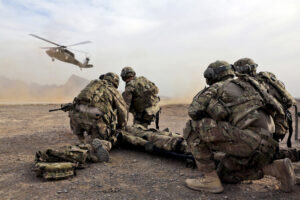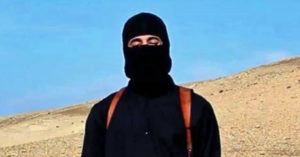On 14 July 2024, as football fans gathered to watch the Euro 2024 final, a fireball ripped through a café in Mogadishu. Al-Shabaab, an affiliate of al-Qaeda, later claimed responsibility for the blast and the five lives it extinguished. It was a message to the Somali government — and to the West as a whole — that the past decade’s attempts to defeat the terror group had stalled.
But it was also a threat. In 2007, 22,000 African Union (AU) troops were brought into Somalia to support Mogadishu’s fragile government. But at the end of this year, they are scheduled to leave. And there’s every reason to believe that al-Shabaab could take over and destabilise neighbouring nations with a large Somali diaspora. Indeed, there are already reports that al-Shabaab is in contact with the Iran-backed Houthis in Yemen. Such an alliance would further imperil international shipping routes and have enormous consequences for the world economy.
It could also spark more serious threats closer to home. After all, in the aftermath of 9/11, it was in Somalia — not Iraq or Afghanistan — that a new generation of Western jihadists were spawned.
By the turn of the century, London had already become a haven for dissident preachers and jihadi ideologues: Abu Qatada, Abu Mus’ab al-Suri, Hani al-Sibai and Abu Hamza al-Masri. But it also produced its own English-speaking radicals, who coalesced in a square mile known as Lisson Green, in the very same borough as the Houses of Parliament.
Many of the youngsters who grew up in the area had been too young to be meaningfully aware of the recent conflicts in Afghanistan or Bosnia, but they swam in the ideological currents of the aftermath. Sheikh Abu Qatadah, a top jihadi ideologue, used to deliver sermons there on Fridays. As did Anwar Awlaki, a firebrand preacher who openly gave jihadist talks and was a favourite of Mohammed Emwazi, the man who would later become known as “Jihadi John”. Just down the road, Muhammad al-Rifai, a man who claimed to be the Caliph of the whole Muslim world, lived in a council flat.
A few years ago, one of those who heard their sermons agreed to speak to me using the pseudonym Abdullah. Abdullah grew up in Lisson Green and attended the youth club where I worked for one summer in 2003. He told me about the Islamist currents that dominated the area: even the local five-a-side soccer team was named the “Shishanees” (the Chechens). Abdullah became devout during his teenage years and joined Hizb ut-Tahrir, an Islamist organisation that called for the return of the Caliphate. As an activist, he invited many of its members to his secondary school to give speeches to the Muslim pupils.
The youngsters stewed in this ideological cauldron when a new conflict emerged in Somalia. The fall of strongman Mohamed Siad Barre’s government in 1991 created a power vacuum and a decade-long civil war. Eventually, the Somali people’s desire for peace and order resulted in the rise of the Islamic Courts Union (ICU). This group, founded by religious scholars, established a semblance of law and order in the capital Mogadishu and succeeded in pushing out the nation’s CIA-backed warlords by 2006. In Lisson Green, this was a cause for celebration. A new generation of British Muslims had grown up with tales of Western jihadis and their spirited adventures in Afghanistan, Bosnia and Chechnya, and they were eager to emulate them. Suddenly, they saw their opportunity in Somalia.
They were encouraged in this by Abdul Majid, an outspoken Somali-British local who drew many youngsters into his orbit, especially Bilal Berjawi, who attended the same youth club as Abdullah. Berjawi was a pug-faced bruiser with a Beckham-like voice and a reputation as a fighter. He attracted a circle of boys from the youth club and they travelled to Somalia in 2007.
Some described the times under the ICU as idyllic. Some, such as Mohammed Ezzouek, went there claiming to want to study Islam and live under Islamic law. But the good times did not last. The Ethiopian government, alarmed by the presence of the ICU on its border, pushed them out of Mogadishu and rearmed the warlords who were back in the capital by the end of the year. This attack on the ICU radicalised its youth wing and it later split off as a separate organisation known as Harakat al-Shabaab al-Mujahideen — the Young Mujahideen Movement, or al-Shabaab for short. And as they embarked on a war against the Ethiopians, al-Shabaab declared allegiance to al-Qaeda.
Faced with this threat, the young men from Lisson Green fled Somalia trying to reach safety in Kenya. Once there, some were detained and interrogated, while a handful returned to the UK having turned their back on both Somalia and Islamist ideology. Others, however, became more radicalised. And chief among them was Berjawi, who became a full member of al-Shabaab and was purportedly trained by Harun Fazul, the man behind the 1998 terrorist bombings in East Africa. Indeed, Fazul chose Berjawi as the leader of the London network. Over the next few years, Berjawi came in and out of the UK to fundraise for the group.
After proving himself, Berjawi went on to become an important commander for al-Shabaab, until he was killed in 2012 by the US in a drone strike, reportedly with British complicity. But Berjawi left behind those he recruited: in particular, Mohammed Sakr, Mohammed Emwazi and Alexanda Kotey. Sakr and Emwazi tried to enter Somalia again in 2009, using a cover story that they were going on safari in Tanzania. In Syria, Emwazi and Kotey would become the Western faces of the Caliphate.
Meanwhile, those who could not take part in jihad in Syria were recruited to carry out terror attacks in the UK. Michael Adebolajo, an associate of Berjawi who had tried to join al-Shabaab, murdered British soldier Lee Rigby in Woolwich in 2013. Three years later, two promising university students, Tarik Hassane and Suhaib Majeed, were convicted for their part in an Isis terror plot in West London; both men were from Lisson Green or nearby. They had been acting under Kotey’s instructions.
This was the effect of the rise of al-Shabaab. At the time, policymakers appeared to be more preoccupied with threats emerging from Afghanistan and Iraq, or dealing with the aftermath of major terror attacks such as the one that took place in London on 7/7, to appreciate the presence al-Shabaab had on a small but significant number of young Muslims in the West. Somalia appeared distant and war-torn.
Today, we find ourselves in a similar situation, with a turbo-charged jihadi discourse heightened by the horrific situation in Palestine. Young disaffected Muslims watch as the media appears outraged by Russian targeting of hospitals in Ukraine but relatively indifferent when the IDF targets hospitals in Gaza. They see themselves as othered, devalued and forgotten. Spurred on by social media and Telegram groups, they see the likes of the Taliban defeating the Americans or the Houthis doing something for Gaza while the rest of the Muslim world appears impotent.
For them, al-Shabaab offers an animating force. If its flags rise in Mogadishu, a new generation of Western jihadists could return to the Horn of Africa.
Disclaimer
Some of the posts we share are controversial and we do not necessarily agree with them in the whole extend. Sometimes we agree with the content or part of it but we do not agree with the narration or language. Nevertheless we find them somehow interesting, valuable and/or informative or we share them, because we strongly believe in freedom of speech, free press and journalism. We strongly encourage you to have a critical approach to all the content, do your own research and analysis to build your own opinion.
We would be glad to have your feedback.
Source: UnHerd Read the original article here: https://unherd.com/



